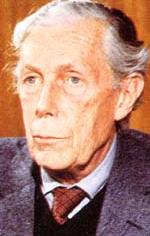Anthony Blunt (Anthony Frederick Blunt)

Anthony Frederick Blunt (26 September 1907 – 26 March 1983), known as Sir Anthony Blunt, KCVO, from 1956 to 1979, was a leading British art historian who in 1964, after being offered immunity from prosecution, confessed to having been a Soviet spy. He had been a member of the Cambridge Five, a group of spies working for the Soviet Union from some time in the 1930s to at least the early 1950s. A closely held secret for many years, his status was revealed publicly by Prime Minister Margaret Thatcher in November 1979, and he was stripped of his knighthood immediately thereafter. Anthony Blunt was Professor of the History of Art at the University of London, director of the Courtauld Institute of Art, and Surveyor of the Queen’s Pictures. His monograph on the French Baroque painter Nicolas Poussin (1967) is still widely regarded as a watershed book in art history. His teaching text and reference work Art and Architecture in France 1500–1700, first published in 1953, reached its fifth edition in a slightly revised version by Richard Beresford in 1999, when it was still considered the best account of the subject.
Anthony Blunt’s role was represented under the name Maurice in Andrew Boyle’s book Climate of Treason in 1979. Maurice was taken from the E. M. Forster novel of that name. Blunt tried to prevent the book’s publication, which was reported in the magazine Private Eye. This drew attention to Blunt. In the House of Commons of the United Kingdom, Prime Minister Margaret Thatcher revealed Blunt’s wartime role, firstly on Thursday 15 November 1979, and in more detail on 21 November. Sir Bernard Ingham, Thatcher’s press secretary, suggested, “I believe she did it because she didn’t see why the system should cover things up. This was early in her prime ministership. I think she wanted to tell the civil service that the politicians decide policy, not the system. She wanted them to know who was boss.” For weeks after Thatcher’s announcement, Blunt was hunted by the press. Once found, he was besieged by photographers. Blunt had recently given a lecture at the invitation of Francis Haskell, Oxford University’s professor of art history. Haskell had a Russian mother and wife and had graduated from King’s College, Cambridge. To the press this made him an obvious suspect. They repeatedly telephoned his home in the early hours of the morning, using the names of his friends and claiming to have an urgent message for “Anthony”.
Although Anthony Blunt was outwardly calm, the sudden exposure shocked him. His former pupil, art critic Brian Sewell, said at the time, “He was so businesslike about it; he considered the implications for his knighthood and academic honours and what should be resigned and what retained. What he didn’t want was a great debate at his clubs, the Athenaeum and the Travellers. He was incredibly calm about it all.” Sewell was involved in protecting Blunt from the extensive media attention after his exposure, and his friend was spirited away to a flat within a house in Chiswick. Queen Elizabeth II stripped Blunt of his knighthood, and he was removed as an Honorary Fellow of Trinity College. After his BBC Television confession at the age of 72, he broke down in tears. Anthony Blunt died of a heart attack at his London home in 1983, aged 75.
Born
- September, 26, 1907
- United Kingdom
- Bournemouth, Hampshire, England
Died
- March, 03, 1983
- United Kingdom
- Westminster, London, England
Cause of Death
- heart attack
Cemetery
- Putney Vale Cemetery and Crematorium
- Wimbledon, London, England
- United Kingdom


